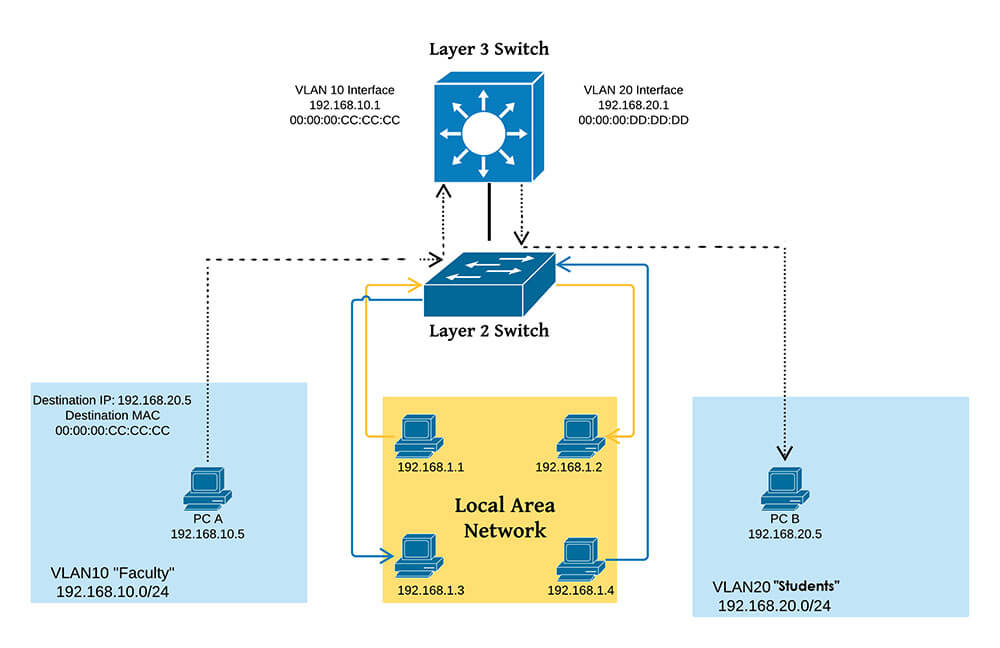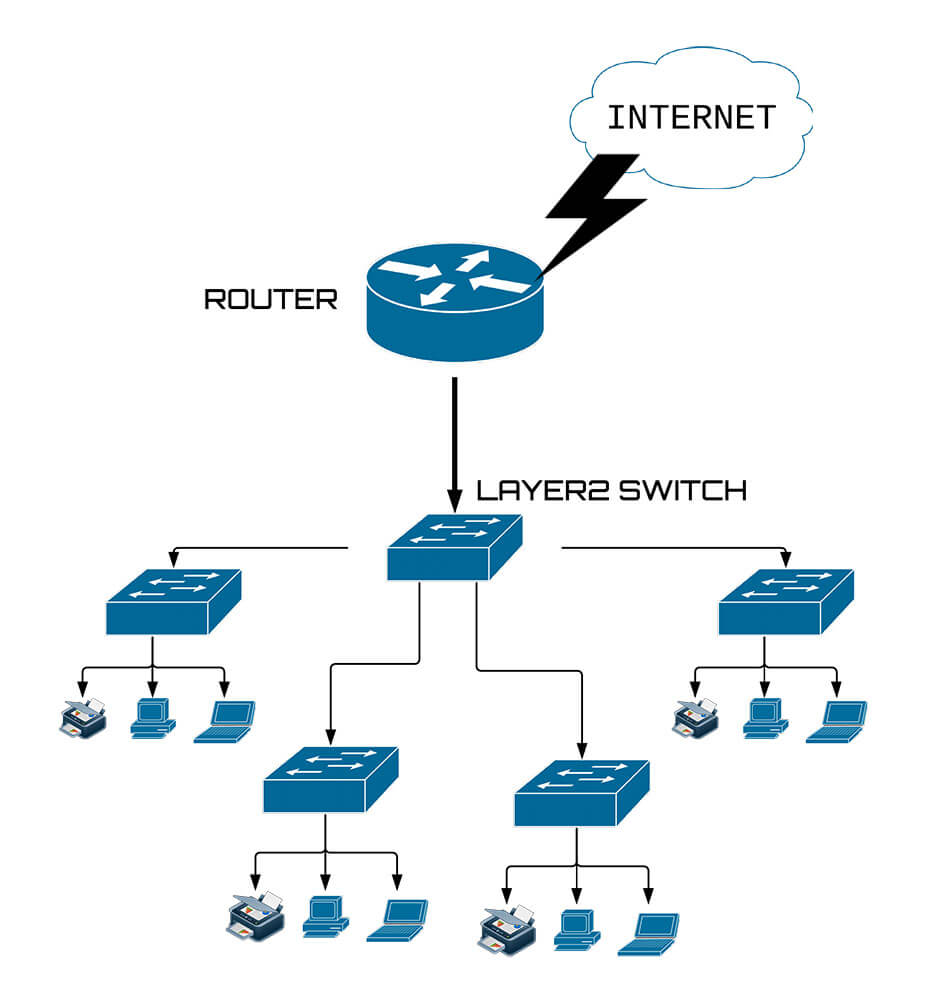In the realm of computer networking, efficiency, speed, and reliability are paramount. As networks grow more complex and demand for high-speed data transfer escalates, the traditional methods of data routing and switching have evolved. Enter Layer 3 switching, a technology that combines the robust routing capabilities of routers with the high-speed performance of switches. This article delves into the intricacies of Layer 3 switching, its significance in modern networking, and its practical applications.
What is Layer 3 Switching?
Layer 3 switching operates at the network layer of the OSI model, the same level as traditional routers. However, unlike routers, which often focus on inter-network communications with an emphasis on security and policy enforcement, Layer 3 switches are designed for speed and efficiency within large, complex networks. They perform routine functions but with the hardware-based speed typically associated with switches.
Key Characteristics of Layer 3 Switching
- Hardware-Based Packet Forwarding: Layer 3 switches use specialized hardware, such as application-specific integrated circuits (ASICs), to perform packet forwarding. This hardware-based approach allows for faster data processing compared to the software-based processing of traditional routers.
- Routing Capabilities: While performing at high speeds, Layer 3 switches also handle routing functions, including path determination and packet forwarding based on IP addresses. They can manage and make decisions using routing protocols such as OSPF, EIGRP, and BGP.
- High Throughput: Layer 3 switches are capable of handling large amounts of data traffic with minimal latency, making them ideal for high-demand environments like data centers and enterprise networks.
- Scalability: These switches can efficiently manage and route data in large-scale networks, providing scalability for growing network demands without significant performance degradation.
How Does Layer 3 Switching Work?
Packet Forwarding
At the core of Layer 3 switching is the ability to forward packets based on their IP addresses. When a packet arrives at the switch, the Layer 3 header is inspected to determine the destination IP address. The switch then uses its routing table, which is dynamically updated by routing protocols, to decide the best path for the packet to reach its destination.
Routing Tables and Protocols
Layer 3 switches maintain routing tables that store information about network paths. These tables are populated and updated using dynamic routing protocols or static routes configured by network administrators. Common routing protocols used by Layer 3 switches include:
- OSPF (Open Shortest Path First): A link-state routing protocol that finds the shortest path for data packets based on a network topology map.
- EIGRP (Enhanced Interior Gateway Routing Protocol): A routing protocol that optimizes routing decisions based on various metrics, including bandwidth and delay, using a distance-vector approach.
- BGP (Border Gateway Protocol): Primarily used for routing between autonomous systems, BGP is essential for large-scale internet routing.
VLAN Support and Inter-VLAN Routing
Layer 3 switches also support Virtual Local Area Networks (VLANs), which segment a network into smaller, manageable sub-networks. Inter-VLAN routing, a key feature of Layer 3 switches, allows communication between these VLANs. This is crucial for maintaining organized and efficient network traffic flow, especially in enterprise environments.
Advantages of Layer 3 Switching
Enhanced Performance
The primary advantage of Layer 3 switching is enhanced performance. By combining routing and switching functions in a single device, Layer 3 switches reduce the need for multiple devices and eliminate bottlenecks associated with traditional routing. This results in higher throughput and lower latency.
Simplified Network Design
Layer 3 switches simplify network design by consolidating routing and switching functions. This reduces the complexity of network architecture, making it easier to manage and troubleshoot. It also decreases the physical footprint and power consumption compared to using separate routers and switches.
Improved Scalability
With the ability to handle large amounts of data traffic and support multiple VLANs, Layer 3 switches provide excellent scalability. They can adapt to growing network demands without significant reconfiguration or additional hardware, making them ideal for expanding businesses and data centers.
Cost-Effectiveness
While Layer 3 switches can be more expensive upfront than traditional Layer 2 switches, their ability to perform routing functions eliminates the need for separate routers in many scenarios. This consolidation can lead to long-term cost savings in terms of hardware, maintenance, and power consumption.
Advanced Security Features
Layer 3 switches often come with advanced security features, such as access control lists (ACLs) and Quality of Service (QoS) policies. These features allow for more granular control over network traffic and enhance overall network security.
Practical Applications of Layer 3 Switching
Enterprise Networks
In large enterprise networks, the need for efficient and scalable network management is critical. Layer 3 switches are ideal for these environments due to their ability to handle high data volumes, support multiple VLANs, and provide robust routing capabilities. They enable seamless communication between different departments and ensure optimal network performance.
Data Centers
Data centers require high-speed, reliable network infrastructure to support vast amounts of data traffic and various applications. Layer 3 switches, with their high throughput and low latency, are essential for maintaining efficient data flow and minimizing downtime. They also support complex network topologies and provide flexibility for future growth.
Campus Networks
Educational institutions with large campus networks benefit from the scalability and performance of Layer 3 switches. These switches can manage traffic between different buildings and departments, ensuring reliable connectivity and efficient use of network resources. They also support advanced features like QoS, which is crucial for prioritizing critical applications.
Internet Service Providers (ISPs)
ISPs need to manage extensive networks with high data traffic and diverse customer requirements. Layer 3 switches enable ISPs to provide high-speed internet services while maintaining efficient routing and network management. Their ability to handle large-scale routing tasks makes them suitable for core and edge network deployments.
Comparing Layer 3 Switching with Traditional Routing
Speed and Performance
The most significant difference between Layer 3 switching and traditional routing is speed. Layer 3 switches use hardware-based packet forwarding, which is much faster than the software-based processing of traditional routers. This makes Layer 3 switches ideal for environments requiring high-speed data transfer.
Complexity and Management
Traditional routers are designed to handle complex routing tasks and provide extensive features for network management and security. While Layer 3 switches offer routing capabilities, they are often simpler to manage due to their consolidated design. However, for very complex network policies and security configurations, traditional routers might still be necessary.
Use Cases
Layer 3 switches are best suited for internal network traffic within large organizations, data centers, and campus networks where high-speed, efficient routing is essential. Traditional routers, on the other hand, are often used for inter-network communications and in scenarios where advanced routing features and security policies are required.
Challenges and Considerations
Cost
While Layer 3 switches offer long-term cost savings, the initial investment can be significant. Organizations need to weigh the benefits of enhanced performance and scalability against the upfront costs.
Configuration Complexity
For organizations unfamiliar with routing protocols and advanced networking concepts, configuring Layer 3 switches can be challenging. Proper training and expertise are required to optimize their performance and fully utilize their capabilities.
Compatibility
Integrating Layer 3 switches into an existing network infrastructure requires careful planning to ensure compatibility with other network devices and protocols. This is particularly important in hybrid environments where both traditional routers and Layer 3 switches are used.
Conclusion
Layer 3 switching represents a significant advancement in network technology, offering the perfect blend of high-speed performance and robust routing capabilities. Its ability to handle large amounts of data traffic, support VLANs, and provide scalability makes it an indispensable asset in modern network infrastructures. Whether in enterprise networks, data centers, or campus environments, Layer 3 switches ensure efficient, reliable, and secure data communication, meeting the ever-growing demands of today's digital world.
By understanding the benefits and applications of Layer 3 switching, organizations can make informed decisions about their network infrastructure, paving the way for enhanced performance and future growth. As networks continue to evolve, Layer 3 switching will undoubtedly remain a cornerstone of efficient and effective network management.







